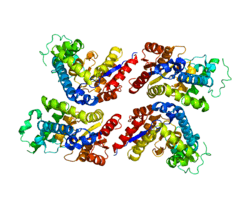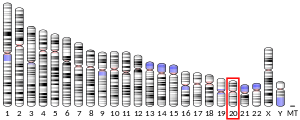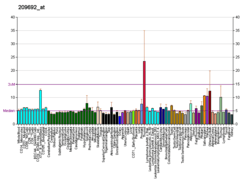EYA2
Eyes absent homolog 2 is a protein that in humans is encoded by the EYA2 gene.[5][6]
Function
This gene encodes a member of the eyes absent (EYA) family of proteins. The encoded protein may be post-translationally modified and may play a role in eye development. A similar protein in mice can act as a transcriptional activator. Five transcript variants encoding three distinct isoforms have been identified for this gene.[6]
Interactions
EYA2 has been shown to interact with GNAI2[7] and GNAZ.[7]
gollark: You misspelt caddyfile.
gollark: <@315587650235138048> Northern England, and I am not.
gollark: *is from UK*
gollark: Maybe some sort of way to wirelessly transmit those passwords would help.
gollark: You should just use a post-it note in a box you carry around.
References
- GRCh38: Ensembl release 89: ENSG00000064655 - Ensembl, May 2017
- GRCm38: Ensembl release 89: ENSMUSG00000017897 - Ensembl, May 2017
- "Human PubMed Reference:". National Center for Biotechnology Information, U.S. National Library of Medicine.
- "Mouse PubMed Reference:". National Center for Biotechnology Information, U.S. National Library of Medicine.
- Abdelhak S, Kalatzis V, Heilig R, Compain S, Samson D, Vincent C, Weil D, Cruaud C, Sahly I, Leibovici M, Bitner-Glindzicz M, Francis M, Lacombe D, Vigneron J, Charachon R, Boven K, Bedbeder P, Van Regemorter N, Weissenbach J, Petit C (Feb 1997). "A human homologue of the Drosophila eyes absent gene underlies branchio-oto-renal (BOR) syndrome and identifies a novel gene family". Nature Genetics. 15 (2): 157–64. doi:10.1038/ng0297-157. PMID 9020840.
- "Entrez Gene: EYA2 eyes absent homolog 2 (Drosophila)".
- Fan X, Brass LF, Poncz M, Spitz F, Maire P, Manning DR (Oct 2000). "The alpha subunits of Gz and Gi interact with the eyes absent transcription cofactor Eya2, preventing its interaction with the six class of homeodomain-containing proteins". The Journal of Biological Chemistry. 275 (41): 32129–34. doi:10.1074/jbc.M004577200. PMID 10906137.
Further reading
- Andersson B, Wentland MA, Ricafrente JY, Liu W, Gibbs RA (Apr 1996). "A "double adaptor" method for improved shotgun library construction". Analytical Biochemistry. 236 (1): 107–13. doi:10.1006/abio.1996.0138. PMID 8619474.
- Zimmerman JE, Bui QT, Steingrímsson E, Nagle DL, Fu W, Genin A, Spinner NB, Copeland NG, Jenkins NA, Bucan M, Bonini NM (Feb 1997). "Cloning and characterization of two vertebrate homologs of the Drosophila eyes absent gene". Genome Research. 7 (2): 128–41. doi:10.1101/gr.7.2.128. PMID 9049631.
- Yu W, Andersson B, Worley KC, Muzny DM, Ding Y, Liu W, Ricafrente JY, Wentland MA, Lennon G, Gibbs RA (Apr 1997). "Large-scale concatenation cDNA sequencing". Genome Research. 7 (4): 353–8. doi:10.1101/gr.7.4.353. PMC 139146. PMID 9110174.
- Duncan MK, Kos L, Jenkins NA, Gilbert DJ, Copeland NG, Tomarev SI (Jul 1997). "Eyes absent: a gene family found in several metazoan phyla" (PDF). Mammalian Genome. 8 (7): 479–85. doi:10.1007/s003359900480. PMID 9195991.
- Borsani G, DeGrandi A, Ballabio A, Bulfone A, Bernard L, Banfi S, Gattuso C, Mariani M, Dixon M, Donnai D, Metcalfe K, Winter R, Robertson M, Axton R, Brown A, van Heyningen V, Hanson I (Jan 1999). "EYA4, a novel vertebrate gene related to Drosophila eyes absent". Human Molecular Genetics. 8 (1): 11–23. doi:10.1093/hmg/8.1.11. PMID 9887327.
- Fan X, Brass LF, Poncz M, Spitz F, Maire P, Manning DR (Oct 2000). "The alpha subunits of Gz and Gi interact with the eyes absent transcription cofactor Eya2, preventing its interaction with the six class of homeodomain-containing proteins". The Journal of Biological Chemistry. 275 (41): 32129–34. doi:10.1074/jbc.M004577200. PMID 10906137.
- Clark SW, Fee BE, Cleveland JL (Feb 2002). "Misexpression of the eyes absent family triggers the apoptotic program". The Journal of Biological Chemistry. 277 (5): 3560–7. doi:10.1074/jbc.M108410200. PMID 11700312.
- Fee BE, Doyle CA, Cleveland JL (Feb 2002). "A novel Eyes Absent 2 protein is expressed in the human eye". Gene. 285 (1–2): 221–8. doi:10.1016/S0378-1119(02)00404-3. PMID 12039049.
- Fougerousse F, Durand M, Lopez S, Suel L, Demignon J, Thornton C, Ozaki H, Kawakami K, Barbet P, Beckmann JS, Maire P (2003). "Six and Eya expression during human somitogenesis and MyoD gene family activation". Journal of Muscle Research and Cell Motility. 23 (3): 255–64. doi:10.1023/A:1020990825644. PMID 12500905.
- Zhang L, Yang N, Huang J, Buckanovich RJ, Liang S, Barchetti A, Vezzani C, O'Brien-Jenkins A, Wang J, Ward MR, Courreges MC, Fracchioli S, Medina A, Katsaros D, Weber BL, Coukos G (Feb 2005). "Transcriptional coactivator Drosophila eyes absent homologue 2 is up-regulated in epithelial ovarian cancer and promotes tumor growth". Cancer Research. 65 (3): 925–32. PMID 15705892.
- Rual JF, Venkatesan K, Hao T, Hirozane-Kishikawa T, Dricot A, Li N, Berriz GF, Gibbons FD, Dreze M, Ayivi-Guedehoussou N, Klitgord N, Simon C, Boxem M, Milstein S, Rosenberg J, Goldberg DS, Zhang LV, Wong SL, Franklin G, Li S, Albala JS, Lim J, Fraughton C, Llamosas E, Cevik S, Bex C, Lamesch P, Sikorski RS, Vandenhaute J, Zoghbi HY, Smolyar A, Bosak S, Sequerra R, Doucette-Stamm L, Cusick ME, Hill DE, Roth FP, Vidal M (Oct 2005). "Towards a proteome-scale map of the human protein-protein interaction network". Nature. 437 (7062): 1173–8. doi:10.1038/nature04209. PMID 16189514.
External links
- PDBe-KB provides an overview of all the structure information available in the PDB for Human Eyes absent homolog 2 (EYA2)
This article is issued from Wikipedia. The text is licensed under Creative Commons - Attribution - Sharealike. Additional terms may apply for the media files.





